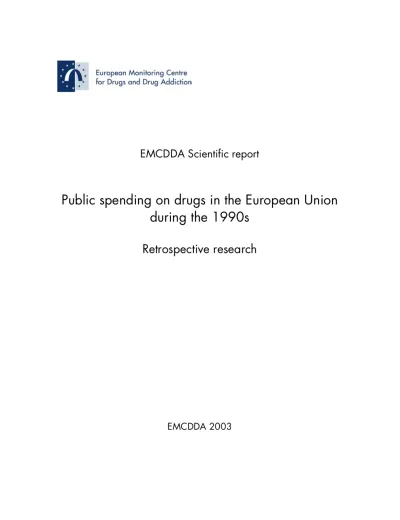Summary
This retrospective study presents an overview of drug-related public expenditure engaged by the countries of the European Union during the decade 1990–2000. The aim of the research was to collect at EU level existing figures on public expenditure in the field of drugs, what is usually called ‘the drugs budget’.
This report was commissioned by the EMCDDA and prepared byProfessor Pierre Kopp (Pantheon-Sorbonne University) and Professor Philippe Fenoglio (Nancy II University).
Download as PDF
public_expenditure-2003.pdf
PDF files are made available as a convenience. In cases where the EMCDDA is not the originator of the document, please be aware that any PDFs available on this page may not be authoritative or there may be more recent versions available. While we make every effort to ensure that these files are definitive, before using or citing them, we recommend that you consult the publisher's website or contact the author(s) to check for more recent versions.
Abstract
The national decision maker is preoccupied with the appropriate allocation of the precious resources at his disposal. Therefore he is entitled to demand from national and European public agencies information of high analytical quality on the actions undertaken in the field of drugs. Measuring public expenditure for these actions is an important indicator for assessing the commitment and efforts of any government in dealing with the drug problem.
This retrospective study goes in this direction offering a first overview of drug-related public expenditure engaged by the countries of the European Union during the last decade (1990–2000). Our results, although interesting, must be read in the light of the methodological constraints and the limits posed by the lack of comprehensive information throughout Europe.
In this research we aimed to collect at EU level existing figures on public expenditure in the field of drugs, what is usually called ‘the drugs budget’.
This is composed of two types of expenditure: public expenditure directly labelled as drug-related – ‘direct expenditure’ – and the resources spent by public authorities and generic services (police, customs, public health institutions etc.) to deal with questions arising from drugs – ‘indirect expenditure’. While the figures relating to ‘direct expenditure’ (such as a drug unit or a drug squad) are easy to retrieve, calculating the level of ‘indirect expenditure’ is based on a complex estimate of the proportion of activity each public authority carries out in the field of drugs. Moreover, public expenditure also includes expenditure at central, regional and local level.
In this study our calculations have been based on these two types of figures relying only on the data available. Unfortunately, not all EU countries have carried out expenditure surveys particularly as regards ‘indirect expenditure’ and this has partially affected the results of the study. In any case, the heterogeneity of data is frequent in the area of drug studies and the sizing up of the obstacles encountered will constitute a strong motive to homogenise the methods of compiling relevant data. The present study therefore represents a starting point opening the way for other work devoted to assessing public drug policy in the EU. Data collected come from different contacts in each Member State of the European Union.
Although the reference period for this research is the decade 1990–2000, it contributes to enlightening current decisions in the field of drugs. Effectively, public spending is a macro-economic aggregate that evolves little, particularly in those countries belonging to the European Union. The largest portion of the ‘drugs budget’ covers the operating costs of the public administrations where public servants deal with the consequences of drug use. It is probable that the cost represented by the prison system (or health-care system) for drug addiction varies little from year to year. Certainly, when a change occurs, for example a new system of substitution treatment or the number of people infected with HIV, this will create consequences in matters of public spending. In any case, the extent of these changes is so small in the total public cost for drugs, that even when these vary greatly it has little effect on total spending.
The study concentrated on data from EU countries although it contains, for the purpose of comparison, data concerning the United States of America and the Helvetian Confederation. The comparison with the United States is directed at better understanding the particular characteristics and originality of the public policy introduced by the European Union. The presence of the Helvetian Confederation is justified by the influence of debates in the area of health policy of this country on the other countries of the Union.
Having defined the ‘drug budgets’ and highlighted the constraints, we can now proceed to the presentation of the main results that are divided between two main facets of drug-related expenditure: health care and law enforcement.









